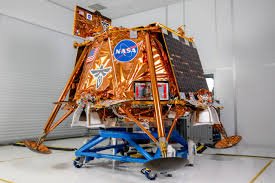NASA, in collaboration with Firefly Aerospace, has achieved another remarkable milestone in lunar exploration. On March 2, 2025, the Blue Ghost lunar lander successfully touched down on the Moon’s surface, landing in the Mare Crisium region at 3:34 a.m. EST. This achievement marks a significant step forward in space exploration, particularly for commercial space companies working alongside NASA.
The successful landing of Blue Ghost makes Firefly Aerospace the second private company to land a spacecraft on the Moon, following Intuitive Machines’ Odysseus lander in 2024. This mission is part of NASA’s Commercial Lunar Payload Services (CLPS) initiative, which aims to work with private industry to develop and execute lunar missions. By using commercial partners, NASA hopes to establish a sustainable lunar presence and pave the way for future missions, including those planned under the Artemis program.
What is Blue Ghost?

Blue Ghost is a robotic lunar lander developed by Firefly Aerospace, a Texas-based company specializing in space transportation. Named after a rare species of firefly that emits a constant glow, the lander is designed to deliver scientific instruments and technology payloads to the Moon. The goal of these missions is to enhance our understanding of the lunar environment, test new technologies, and support future human missions.
This first Blue Ghost mission carried ten NASA-funded payloads, each designed for specific research and technological demonstrations. The lander is expected to operate for approximately one lunar day, equivalent to 14 Earth days, before it is rendered inactive by the freezing lunar night.
A Smooth Touchdown in Mare Crisium
Blue Ghost’s landing site, Mare Crisium, is a vast lunar basin located on the Moon’s near side. The region was chosen due to its geological significance and potential for scientific discoveries. Scientists believe that studying this area can provide valuable insights into the Moon’s volcanic history and surface composition.
The lander’s descent and touchdown were executed with remarkable precision, using autonomous navigation systems and advanced hazard-avoidance technology. Unlike previous missions that relied heavily on real-time input from mission control, Blue Ghost’s onboard systems made split-second decisions to ensure a safe landing.
Following its successful touchdown, the lander deployed its scientific instruments and began transmitting data back to Earth. The mission team celebrated this accomplishment, emphasizing the importance of commercial partnerships in expanding human knowledge of the Moon.
Scientific Goals and Technology Demonstrations
Blue Ghost’s mission is packed with scientific experiments and technology demonstrations that will contribute to NASA’s broader lunar exploration efforts. Some of the key payloads include:
- Lunar Surface Radiation Experiment: This instrument is designed to measure radiation levels on the Moon, which is crucial for planning future crewed missions. Understanding radiation exposure will help NASA develop protective measures for astronauts during long-term lunar stays.
- Regolith Interaction Studies: The lander carries experiments to study how lunar dust behaves in microgravity and how it interacts with spacecraft surfaces. Lunar dust is known to be abrasive and can pose challenges for both robotic and human missions.
- Navigation and Communication Technology: Blue Ghost is testing next-generation navigation and communication systems that will be essential for future lunar missions. These technologies aim to improve real-time location tracking and data transmission between Earth and the Moon.
- Thermal Management Testing: One of the biggest challenges for lunar missions is dealing with extreme temperature fluctuations. This mission includes experiments on thermal coatings and insulation materials that could protect future lunar habitats and equipment.
- Water Detection and Resource Utilization: NASA is keen on finding sustainable ways to use lunar resources, especially water ice. One of the payloads is designed to scan the lunar surface for signs of water, which could eventually support human colonies.
These experiments will contribute to NASA’s long-term goal of establishing a permanent human presence on the Moon under the Artemis program.
Challenges and Triumphs
Like any space mission, Blue Ghost’s journey to the Moon was not without challenges. The lander had to endure the harsh environment of space, navigate accurately to its landing site, and deploy its instruments flawlessly. Some of the biggest hurdles included:
- Launch and Space Travel Risks: The journey from Earth to the Moon is always filled with uncertainties. Any malfunction during launch or transit could have jeopardized the mission.
- Lunar Surface Conditions: The Moon’s surface is covered with fine, electrostatically charged dust that can interfere with equipment. Engineers had to ensure that the lander’s systems were designed to withstand these conditions.
- Autonomous Landing: Unlike the Apollo missions, which had human pilots guiding the descent, Blue Ghost relied entirely on artificial intelligence and onboard sensors to land safely.
Despite these challenges, the mission was executed successfully, proving the effectiveness of commercial lunar landers and paving the way for future missions.
Firefly Aerospace’s Role in the Future of Lunar Exploration
Firefly Aerospace is quickly emerging as a key player in the commercial space sector. Founded in 2014, the company has been working on innovative space transportation systems, including small and medium-sized rockets, lunar landers, and in-space propulsion technology.
The success of Blue Ghost’s first mission is just the beginning. Firefly is already planning a second lunar mission in 2026, which will aim to explore the Moon’s far side—a region that remains largely unexplored. This mission will carry more advanced scientific payloads and could play a crucial role in preparing for crewed missions to the Moon’s south pole.
NASA’s CLPS initiative continues to encourage private companies like Firefly Aerospace, Intuitive Machines, and Astrobotic to develop cost-effective lunar transportation solutions. The success of these commercial ventures will not only support NASA’s Artemis missions but also create opportunities for international space agencies and private enterprises looking to conduct research on the Moon.
The Broader Impact of Blue Ghost’s Success
The successful landing of Blue Ghost represents more than just another space mission—it signals a shift in how lunar exploration is being conducted. Instead of relying solely on government agencies, NASA is fostering an ecosystem where commercial partners play an active role in space exploration. This approach makes lunar missions more frequent, cost-effective, and innovative.
The data collected from this mission will provide crucial insights into the Moon’s surface conditions, which will help design better landers, rovers, and eventually human habitats. Additionally, technological advancements made during this mission will benefit not just lunar exploration but also future Mars missions and deep-space endeavors.
Looking Ahead: The Future of Lunar Exploration
With each successful mission, humanity moves one step closer to long-term lunar exploration. NASA’s Artemis program aims to return humans to the Moon by the end of the decade, and commercial landers like Blue Ghost will play a key role in building the necessary infrastructure.
Beyond NASA, other space agencies, including those from Europe, China, and India, are planning ambitious lunar missions. The Moon is becoming the focal point of global space exploration, and partnerships between government and private industry will drive innovation and expand our understanding of our closest celestial neighbor.
Final Thoughts
Firefly Aerospace’s Blue Ghost mission is a landmark achievement in space exploration. It demonstrates the potential of commercial partnerships, advances scientific research, and sets the stage for future lunar missions. With more landings planned in the coming years, the Moon is set to become a hub for exploration, research, and possibly even human settlement.
As NASA and its partners continue to push the boundaries of space exploration, one thing is clear: the new era of lunar exploration has begun, and the journey to understanding the Moon is far from over.





